Introduction
- Managing cultural diversity is a crucial task for international organizations.
- The effect of cultural diversity can by both positive and negative.
- The outcomes of cultural diversity depend on managing strategies.
Cultural diversity in the workplace is a widely discussed matter around the globe. The topic is of increased importance to international organizations since, by nature, they are forced to deal with employees with varying cultural background. Cultural diversity can be both beneficial and disadvantageous for companies. The effects of the matter are highly dependable on a utilized strategy of managing workplace cultural diversity.
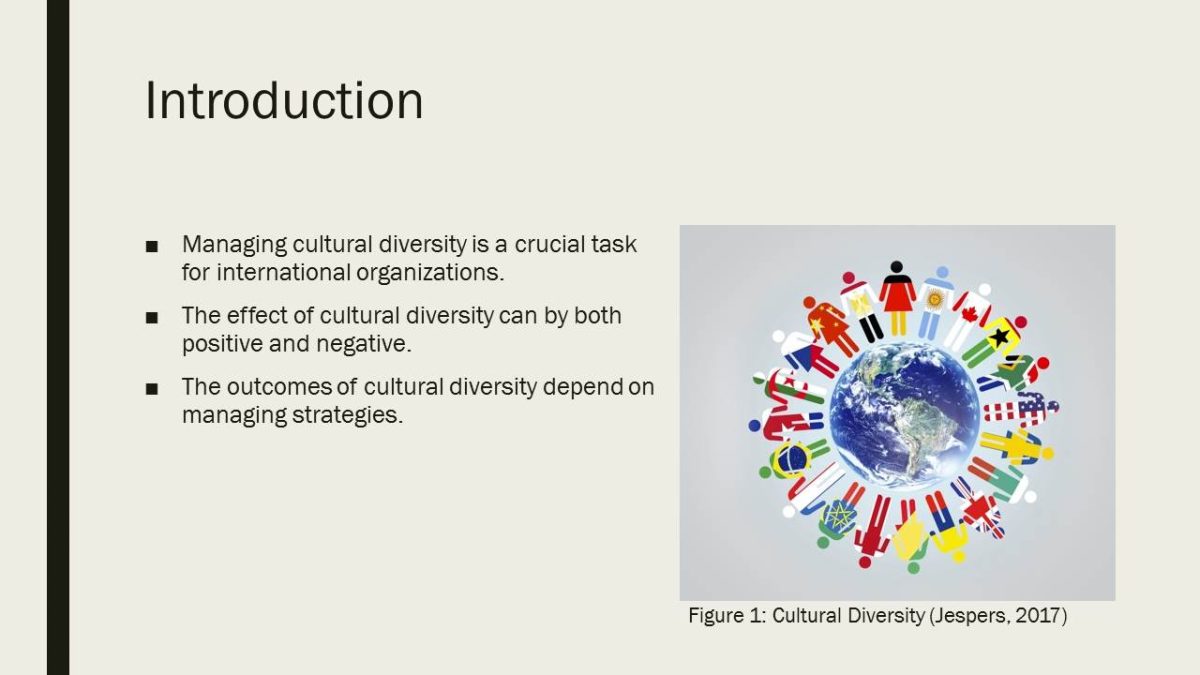
Purpose and Methods
Purpose:
- Identify the gap between current research and practice in terms of managing workplace cultural diversity.
Methods:
- Review literature to summarize the current knowledge concerning the topic;
- Determine criteria for evaluation of workplace cultural diversity;
- Analyze three international organizations for efficiency of cultural diversity management.
Projection:
- The gap is expected to be insignificant.
Even though cultural diversity is widely discussed in all kinds of literature, it is unclear what methods are currently used by international organizations to manage cultural diversity. The present paper aims at summarizing the current research about the subject and identify the gap between theory and practice. In order to achieve the purpose, cultural diversity strategies of three multi-national organizations are evaluated and findings are summarized. Since international companies are affected by the choice of diversity management strategy the most, there expected to be an insignificant inconsistency with recent research.
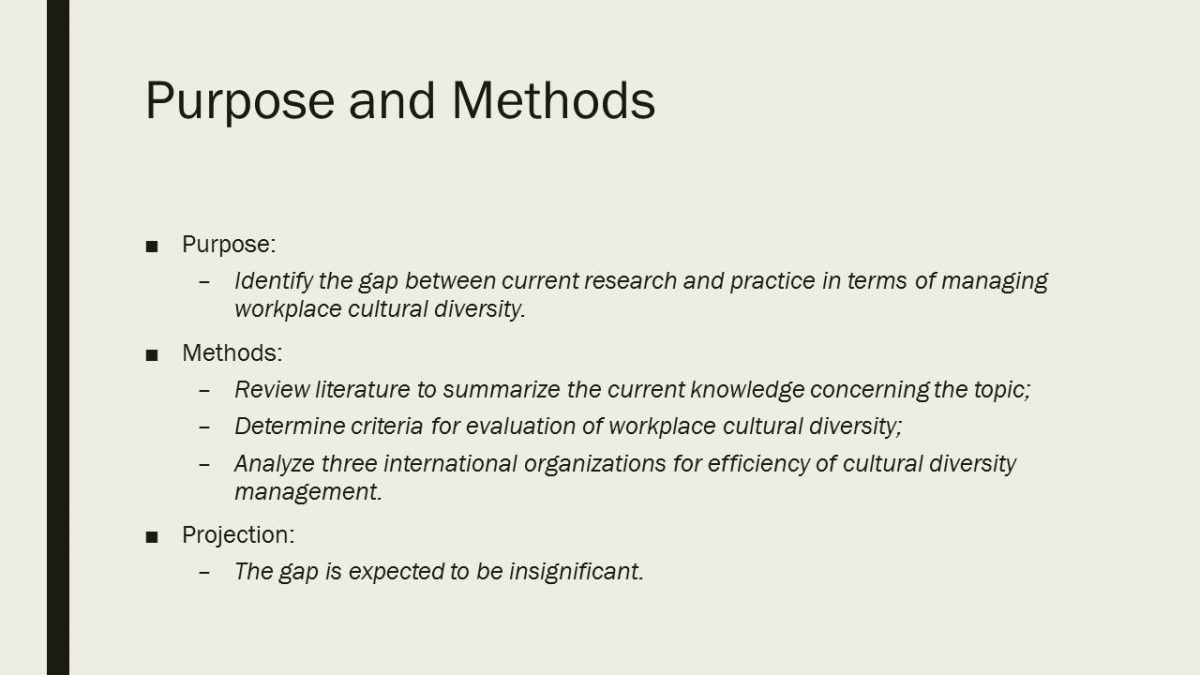
Literature Review: Implications of Workplace Cultural Diversity
Benefits:
- Increased creativity and innovation (Lambert, 2016);
- Ability to serve a wider variety of clients (Ellemers & Rink, 2016).
Disadvantages:
- Lost productivity, struggle to achieve harmony, and dysfunctional conflicts (Martin, 2014).
- High turnover (Ellemers & Rink, 2016).
The effects of workplace cultural diversity can be both positive and negative depending on adopted strategies. On the one hand, cultural diversity is associated with increased creativity and innovation (Lambert, 2016). Additionally, Ellemers and Rink (2016) point out that cross-cultural teams can serve a wider variety of clients since they can understand the needs of different cultures. On the other hand, inappropriate strategies for managing cultural diversity may lead to adverse outcomes. Lambert (2016) mentions that innovation is not guaranteed in the organizations where it is not valued at all levels. Moreover, Ellemers and Rink (2016) state that cross-cultural teams may have communications problems and high turnover rates when managed poorly. In brief, the choice of administrative methods is vital to ensure the efficiency of culturally diverse organizations.
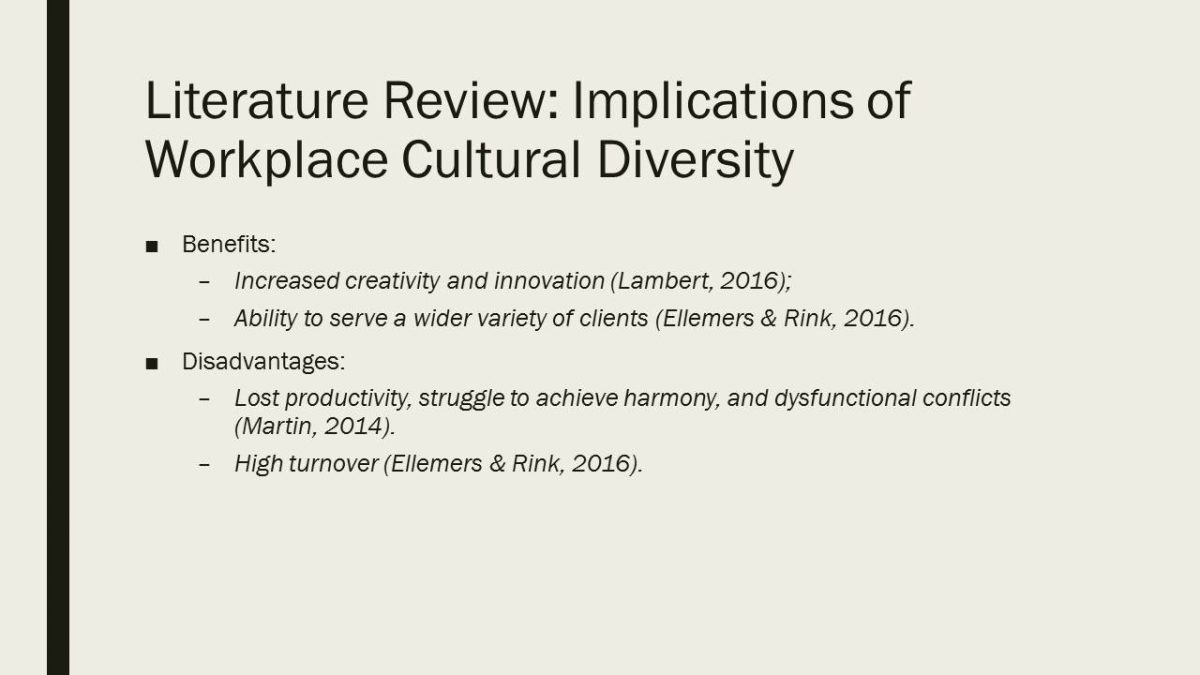
Literature Review: Theoretical Framework
Hofstede’s cultural dimensions:
- Individualism vs. collectivism;
- Masculinity vs. femininity;
- Uncertainty avoidance;
- Power distance;
- Long-term vs. short-term orientation;
- Confucian Dynamism.
Hall’s theory of communication:
- High context countries vs. low context countries.
The choice of strategies is to be based on a theoretical framework to ensure its performance. The reviewed literature proposed using Hofstede’s cultural dimensions and Hall’s high and low context cultures. Even though these theoretical underpinnings are dated more than half a century ago, they are still valid and reliable (Bakir et al., 2014; Wood & Wilberger, 2015). Hall’s model of cultural communication describes how much the context of a conversation is valued. Hofstede’s initial concept included four cultural dimensions: individualism vs. collectivism, masculinity vs. femininity, uncertainty avoidance, and power distance; however, later Confucian dynamism and time orientation were added to the theory (Bakir et al., 2014; Wood & Wilberger, 2015, Godiwalla & Bronson, 2016). According to the theory, managers of multi-cultural companies are to compare the six dimensions and adjust administrative policies accordingly.
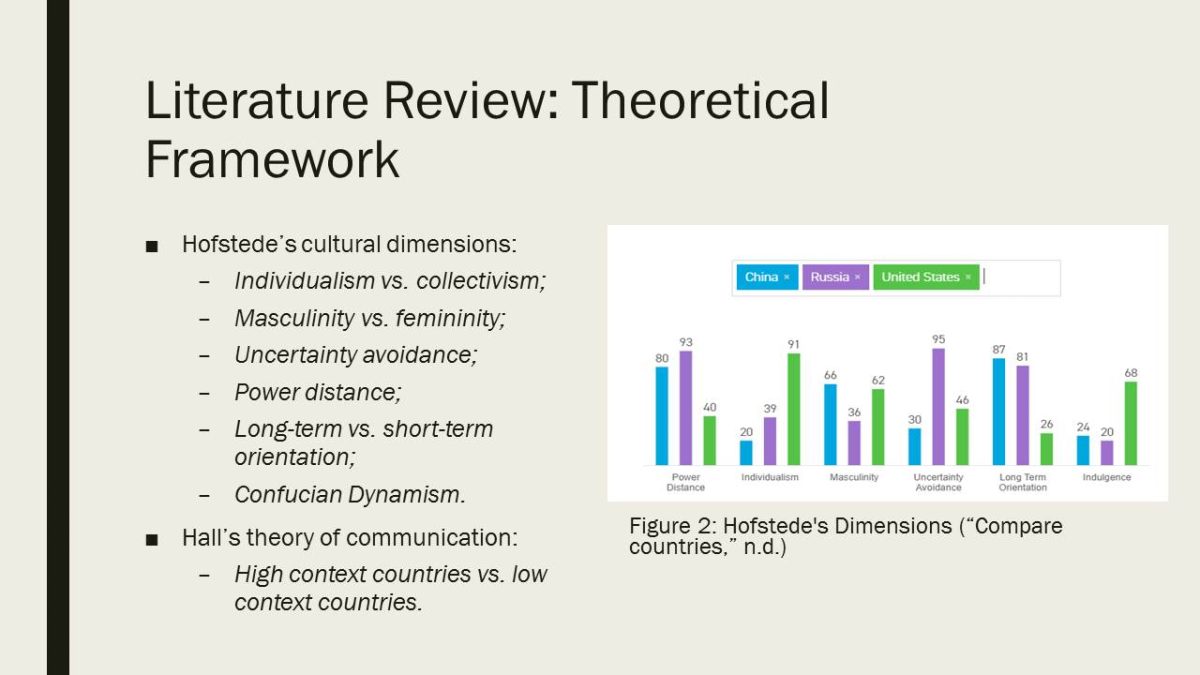
Literature Review: Strategies for Managing Workplace Cultural Diversity
- Value based management (Hopkins & Scott, 2016);
- CEO’s commitment to diversity (Ng and Sears, 2018);
- Fair appraisal of personnel (Sharma, 2016);
- Adjustment of values and strategies depending on the country of operation (Godiwalla & Bronson, 2016).
A theory should be effectively translated into practices to guarantee positive outcomes. The reviewed literature emphasizes the importance of the CEO’s commitment to diversity, promoted VBL, and fair appraisal of personnel (Hopkins & Scott, 2016; Ng and Sears, 2018; Sharma, 2016). Strategy, leadership, human resource practices, organizational culture, unit design, climate, and individual differences were identified as the primary factors that affect diversity management (Guillaume et al., 2017). Additionally, Godiwalla and Bronson (2016) elaborated six specific recommendations for international organizations to improve their supply chain management. In short, there is an abundance of evidence that theory can be used to develop efficient strategies for managing cultural diversity in the workplace.

Organization Selection
International organizations are companies that engage in foreign direct investments and own or control some kind of activity in different countries.
Selected companies:
- Google;
- Amazon;
- Toyota.
Reasons for selection:
- Availability of information;
- Represent different markets;
- Personal reasons.
International organizations are companies that engage in foreign direct investments and own or control some kind of activity in different countries. For the present paper, three companies were identified to assess strategies of managing workplace cultural diversity, including Google, Amazon, and Toyota. These companies were selected since all of them are big international companies that are expected to utilize the most efficient practices. All three companies are widely discussed in press as well as scientific, academic, and business literature. Therefore, there is much information available about these companies. Moreover, the three organizations represent different markets, and the conclusions drawn from the analysis of these enterprises will make the more findings generalizable. The companies were also considered for personal reasons since they are of increased interest to the author. In brief, the combination of objective and subjective factors supported the selection of the three companies.
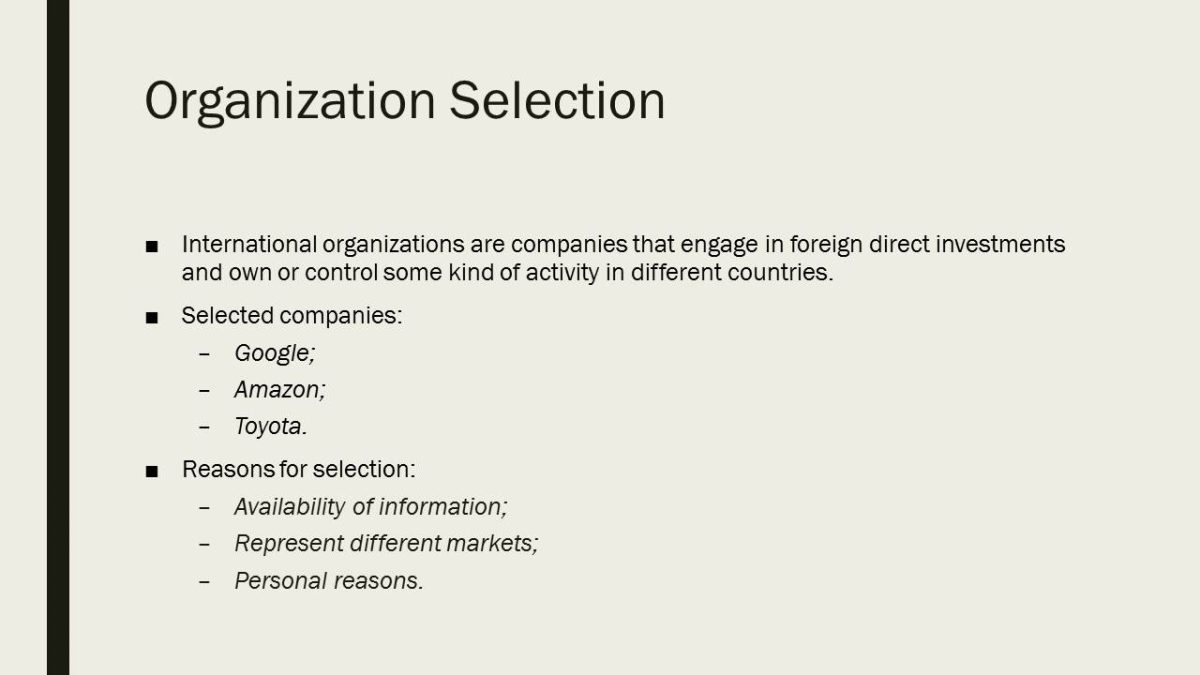
Criteria for Analysis
The literature review suggested 3 criteria:
- Commitment to cultural diversity is to be embedded in the corporate culture;
- Company leaders, including CEO, are to be role models and demonstrate their adherence to diversity principles;
- International companies are to adapt their principles and standards according to Hofstede’s cultural dimensions depending on the country of operations.
The identified criteria for the evaluation of workplace cultural diversity strategies are drawn from the literature review. The findings of the literature review can be summarized into three criteria. First, commitment to cultural diversity is to be embedded in the corporate culture, and the values should be flexible not to contradict any of the cultural values. For example, corporate principles should not insist on informal communication for all employees since, according to Hoff’s theory of high and low context cultures, it may make people uncomfortable (Wood & Wilberger, 2015). Second, company leaders, including CEO, are to be role models and demonstrate their adherence to diversity principles (Ng & Sears, 2018; Guillaume et al., 2017). In other words, managers should not be a part of any affairs that may be viewed as discrimination against cultural minorities. Third, international companies are to adapt their principles and standards according to Hofstede’s cultural dimensions depending on the country of operations (Godiwalla & Bronson, 2016). For instance, in Asian countries, which are believed to be more collectivistic, teams are to be evaluated, while in the US, the emphasis is to be put on appraising individual success.
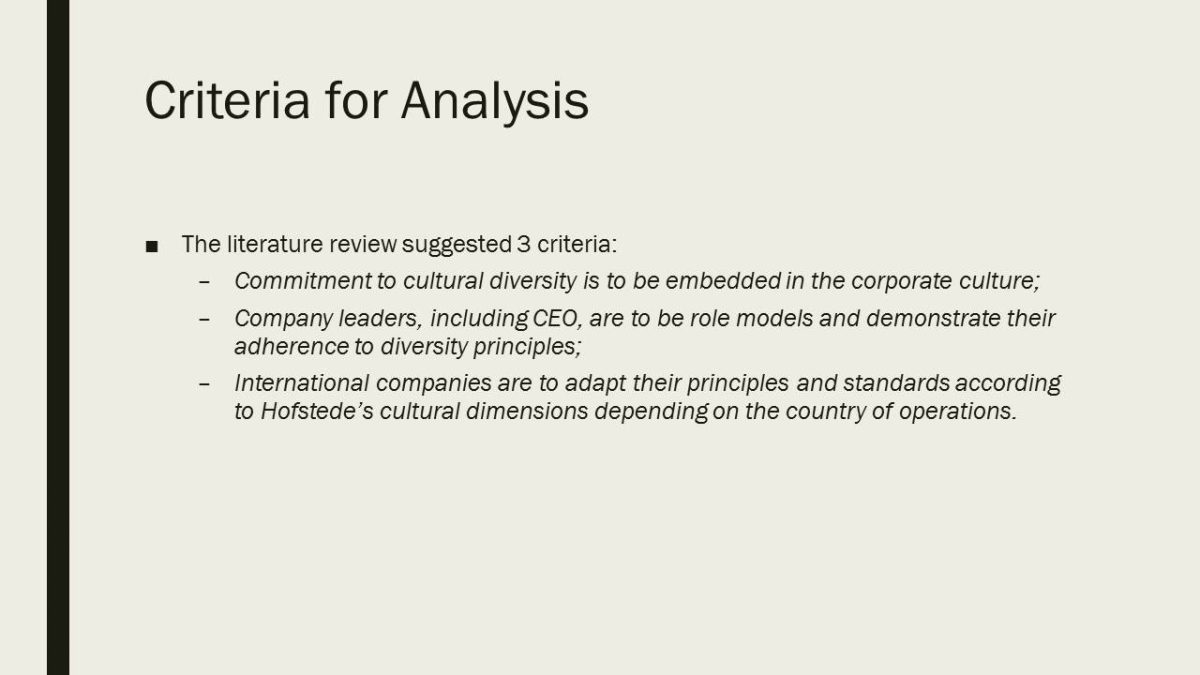
Analysis Results
Amazon:
- The practice of sending feedback about co-workers contradicts individualistic values;
- Company leaders including CEO fail to be role models of cultural diversity;
- The company does not provide autonomy to regional headquarters.
Toyota:
- The company is fully committed to cultural diversity and the corporate culture is flexible;
- All the leaders serve as role models;
- The branches enjoy a high level of autonomy.
Google:
- The company adheres to all the three identified criteria identified in the present paper almost perfectly.
- The company has low workplace diversification due to the nature of the business;
- The company invests millions in research to acquire relevant knowledge about how to improve the situation.
The results of the analysis differ considerably among companies. Amazon underperforms according to all the three identified criteria. First, the company encourages employees to send feedback about their co-workers. This practice may be the reason for the high turnover rates. Second, the company CEO was engaged in a diversity scandal since he denied the recommendation to include more culturally diverse members into the board of directors. Third, the company does not provide enough autonomy to regional headquarters; as a result, it failed to adapt to Chinese culture, and the attempt to expand to China was a failure.
Toyota’s corporate culture is exemplary for managing workplace diversity. However, some employees complain that most of the terms and abbreviations are in Japanese, even in the United States.
Google is also famous for investing millions of dollars into research about workplace cultural diversity. However, despite the utilization of the advanced practices, the company has been criticized for both having low diversification and for pushing too hard for cultural diversity.
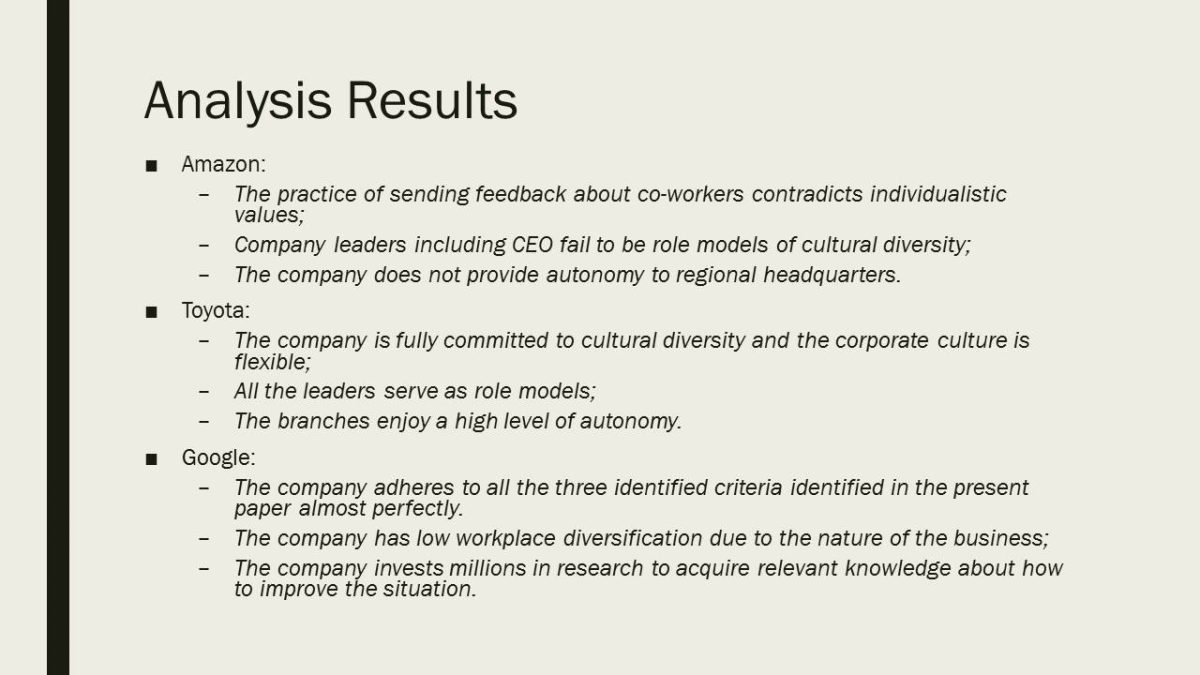
Discussion
The gap between theory and practice in cultural diversity differs considerably among international organizations.
Hofstede’s cultural dimensions and Hoff’s theory of communication can be used to evaluate cultural diversity strategies.
The limitations of the present paper include:
- Non-systematic data;
- Low-validity methods;
- Low generalizability.
Further research is needed to address the weaknesses and limitations of the present paper and confirm the findings.
The results of the evaluation of three companies are inconsistent with initial expectations. It was believed that since large international companies have access to all the recent research and enough resources to implement the findings into practice, they would use effective methods for managing cultural diversity in the workplace. However, the analysis showed otherwise.
Hofstede’s cultural dimensions and Hoff’s theory of communication can be used to evaluate cultural diversity strategies. The validity and reliability for the two theoretical frameworks is confirmed by numerous studies. The two concepts seem to complement each other and, if combined, provide a deeper understudying of differences between cultures. Theory helps to identify applicable principles for assessing cultural diversity strategies. The three criteria utilized in the present paper have proven to be relevant and they can be used in further research.
Three limitations to current study are identified. First, the data about acquired the companies are scarce and non-systematic. Second, the paper lacks identified systematic methods that were used to analyze the data. Finally, the study is limited to only three international organizations, which prevents the results from being generalizable. Further research is needed to address the weaknesses and limitations of the present paper and confirm the findings.
The recommendations for further analysis include identifying high validity qualitative methods to validate the results. Additionally, further research is to assess other types of organizations to improve the generalizability of findings.
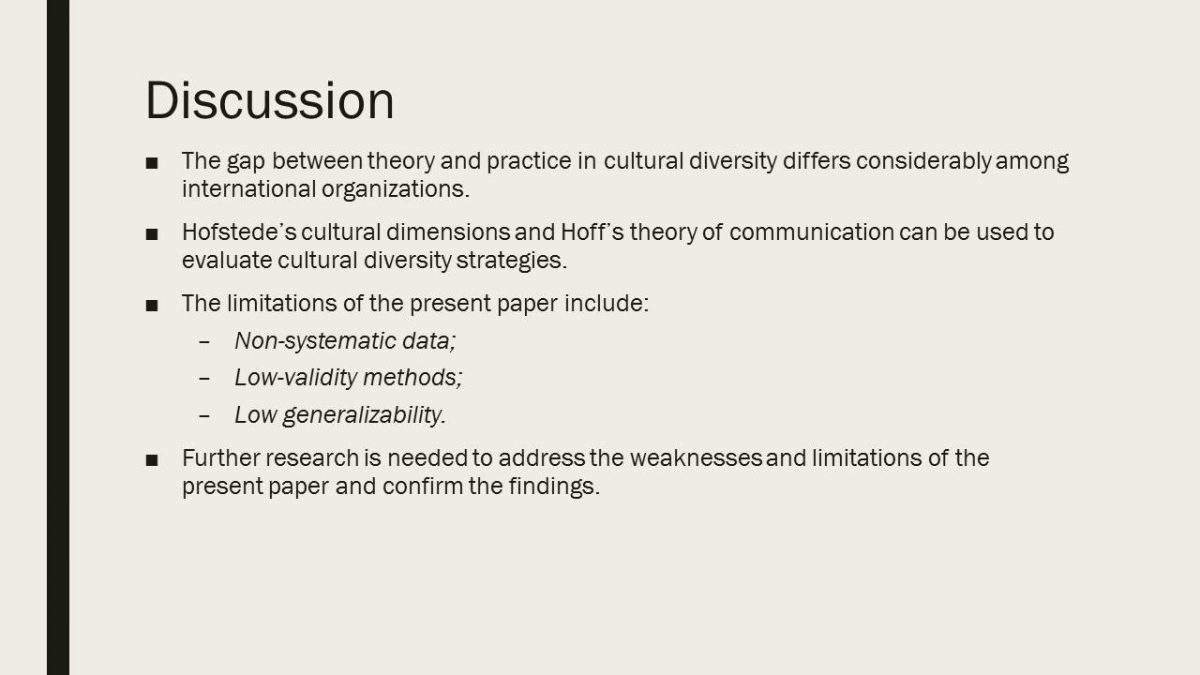
Conclusion
- Utilization of efficient cultural diversity strategies is vital for international organizations.
- The outcomes of cultural diversity may differ considerably depending on the managing methods.
- The findings are inconsistent with the initial projection that the gap between theory and practice concerning cultural diversity management is insignificant.
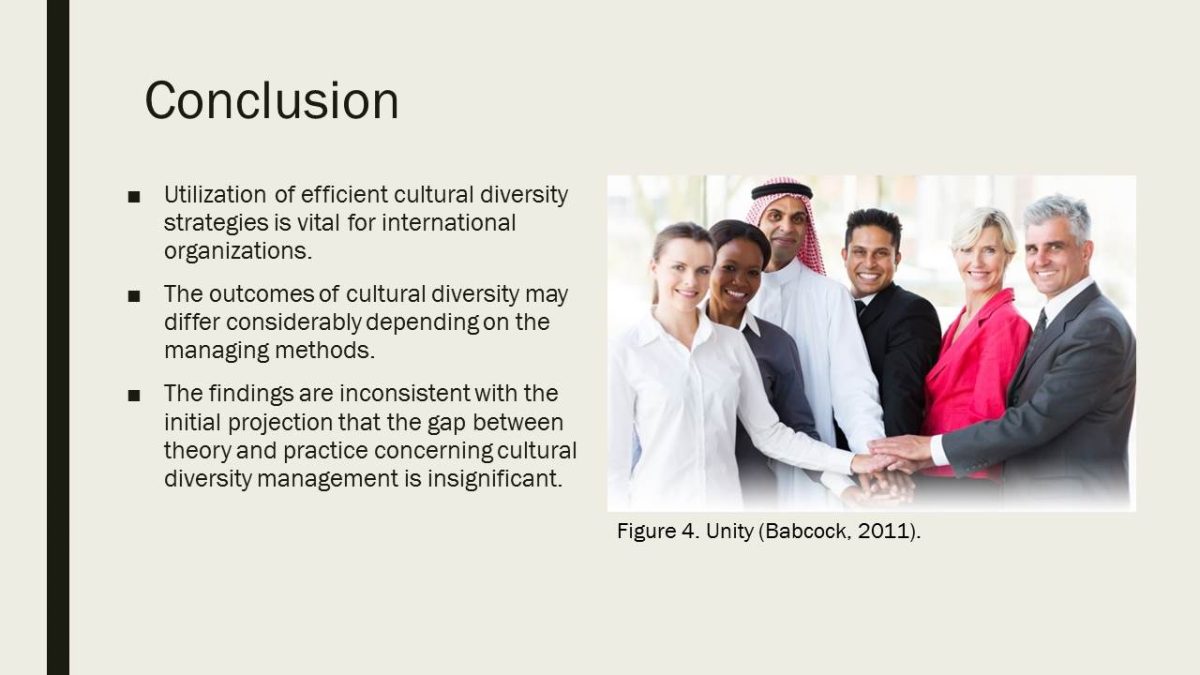
References
Babcock, P. (2011). What CEOs think about diversity. Web.
Bakir, A., Blodgett, J., Vitell, S., & Rose, G. (2014). A preliminary investigation of the reliability and validity of Hofstede’s cross cultural dimensions. Proceedings of the 2000 Academy of Marketing Science (AMS) Annual Conference, (pp. 226-232). Cham, Switzerland: Springer.
Godiwalla, Y. H., & Bronson, J. W. (2015). Diversity management in international supply chains: Strategies for effectiveness. American Journal of Industrial and Business Management, 5(6), 366-375.
Guillaume, Y. R., Dawson, J. F., Otaye‐Ebede, L., Woods, S. A., & West, M. A. (2017). Harnessing demographic differences in organizations: What moderates the effects of workplace diversity? Journal of Organizational Behavior, 38(2), 276-303.
Hopkins, W. E., & Scott, S. G. (2016). Values-based leadership effectiveness in culturally diverse workplaces. Cross Cultural & Strategic
Ellemers, N., & Rink, F. (2016). Diversity in work groups. Current Opinion in Psychology, 11, 49-53.
Jaspers, E. (2017). Cultural diversity makes your team stronger. Web.
Lambert, J. (2016). Cultural diversity as a mechanism for innovation: workplace diversity and the absorptive capacity framework. Journal of Organizational Culture, Communications and Conflict, 20(1), 68-77.
Martin, G. (2014). The effects of cultural diversity in the workplace. Journal of Diversity Management, 9(2), 89-91.
Wood, V., & Wilberger, J. (2015). Globalization, cultural diversity and organizational commitment: Theoretical underpinnings. World Journal of Management, 6(2), 154–171. Management, 23(2), 363–385.
Sharma, A. (2016). Managing diversity and equality in the workplace. Cogent Business & Management, 3(1), 1212682.